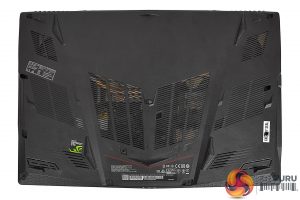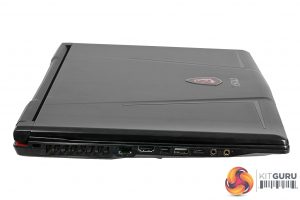Machines of this size simply don’t have the cooling capacity for a GTX 1080, so a GTX 1070 is your limit here. However, with this particular configuration you’re getting a GTX 1060, which is still ample for the vast majority of gaming – especially at the native 1080p resolution of this screen. Plus, you miss out on very little elsewhere.
An Intel Core i7-8750H is the heart of the system and it’s joined by 2 x 8GB sticks of 2,400MHz DDR4 RAM, a 256GB M.2 SSD and a 1TB hard drive. Notably, though, the SSD isn’t a particularly fast model so storage is one area where you may look to make some future upgrades.
Joining these internals is a choice of either a 120Hz 1080p TN screen or a 60Hz 4K IPS model. We opted to test the 120Hz model, as competitive gaming is such a key focus of buying a laptop of this type.
Connectivity is as ample as you’d expect, too. Down the left side there are a pair of audio jacks for headphone and microphone, a USB Type-C, a USB 3.0, mini DisplayPort, full-size HDMI, gigabit Ethernet and the obligatory Kensington lock slot.
Meanwhile on the right is the power input – as you’d expect, a fairly hefty power brick is required here – two more USB 3.0 ports and an SD card reader.
This configuration of the GE63 RGB will set you back £1379.99 while the other main configuration, the GE63 8RF, costs £1940. For that extra outlay you’ll get a 512GB SSD and GTX 1070 graphics card.
If you do fancy performing a few upgrades yourself the base of the laptop can be removed to provide access to the RAM, SSD and hard drive. However, there’s clearly a knack to doing so. Simply removing the screws wasn’t enough to gain us quick access.
 KitGuru KitGuru.net – Tech News | Hardware News | Hardware Reviews | IOS | Mobile | Gaming | Graphics Cards
KitGuru KitGuru.net – Tech News | Hardware News | Hardware Reviews | IOS | Mobile | Gaming | Graphics Cards




